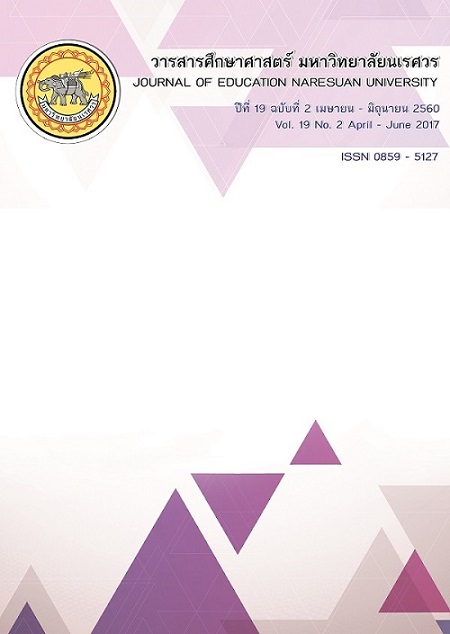การพัฒนาโมเดลปัจจัยเชิงสาเหตุที่มีอิทธิพลต่อความสามารถในการคิดวิเคราะห์ของนักเรียนชั้นประถมศึกษาปีที่ 6 ในโรงเรียนสังกัดสำนักงานเขตพื้นที่การศึกษาประถมศึกษาเลย เขต 1: การวิเคราะห์กลุ่มพหุ
Main Article Content
Abstract
การวิจัยในครั้งนี้ มีวัตถุประสงค์ 1) เพื่อพัฒนาและตรวจสอบความตรงของโมเดลปัจจัยที่มีอิทธิพลต่อความสามารถในการคิดวิเคราะห์ 2) เพื่อทดสอบความไม่แปรเปลี่ยนของรูปแบบและค่าพารามิเตอร์ในโมเดลปัจจัยที่มีอิทธิพลต่อความสามารถในการคิดวิเคราะห์ของนักเรียนระหว่างโรงเรียนขนาดเล็ก โรงเรียนขนาดกลาง และโรงเรียนขนาดใหญ่ กลุ่มตัวอย่างในการวิจัย คือ นักเรียนชั้นประถมศึกษาปีที่ 6 ภาคเรียนที่ 1 ปีการศึกษา 2556 จำนวน 668 คน
จากโรงเรียนจำนวน 85 โรงเรียน ได้มาโดยการสุ่มแบบหลายขั้นตอน (Multi – stage Random Sampling) เครื่องมือวิจัยประกอบด้วย แบบทดสอบวัดเชาวน์ปัญญา 1 ฉบับ จำนวน 34 ข้อ มีค่าความยากระหว่าง 0.24 ถึง 0.80 ค่าอำนาจจำแนกระหว่าง 0.20 ถึง 0.67 ค่าความเที่ยงทั้งฉบับ 0.74 แบบทดสอบวัดความสามารถในการคิดวิเคราะห์ 1 ฉบับ มีจำนวน 30 ข้อ มีค่าความยากระหว่าง 0.28 ถึง 0.68 ค่าอำนาจจำแนกระหว่าง 0.32 ถึง 0.83 ค่าความเที่ยงทั้งฉบับ 0.87 แบบวัดเจตคติต่อการเรียน แบบวัดแรงจูงใจใฝ่สัมฤทธิ์ แบบสอบถามพฤติกรรมการสอนของครู และแบบสอบถามบรรยากาศในชั้นเรียน มีค่าความเที่ยงทั้งฉบับ 0.84, 0.92, 0.94 และ 0.93 ตามลำดับ การวิเคราะห์ข้อมูลใช้สถิติเชิงบรรยาย การตรวจสอบความตรงของโมเดลและการวิเคราะห์กลุ่มพหุ ผลการวิจัย พบว่า
1. การพัฒนาและตรวจสอบความตรงของโมเดลปัจจัยที่มีอิทธิพลต่อความสามารถในการคิดวิเคราะห์ ผลปรากฏว่า ตัวแปรที่มีอิทธิพลทางตรง คือ เชาวน์ปัญญา (INT) และแรงจูงใจใฝ่สัมฤทธิ์ (ACM) และตัวแปรที่มีอิทธิพลทางอ้อม คือ เจตคติต่อการเรียน (LEA) พฤติกรรมการสอนของครู (TTB) และบรรยากาศในชั้นเรียน (CLC) และโมเดลมีความสอดคล้องกลมกลืนกับข้อมูลเชิงประจักษ์ด้วยสถิติวัดระดับความกลมกลืน ( = 214.65, df = 184,
P-value = .06, RMSEA = 0.016, RMR = 0.01, CFI = 0.98, AGFI = 0.96)
2. โมเดลปัจจัยเชิงสาเหตุที่มีอิทธิพลต่อความสามารถในการคิดวิเคราะห์ของนักเรียนที่อยู่ในขนาดของโรงเรียนต่างกันมีความไม่แปรเปลี่ยนด้านรูปแบบโมเดล แต่มีความแปรเปลี่ยนของค่าพารามิเตอร์ของเมทริกซ์สัมประสิทธิ์การถดถอยของตัวแปรสังเกตได้บนตัวแปรแฝงภายนอก (LX) และค่าพารามิเตอร์อื่นๆ ยกเว้นค่าพารามิเตอร์ของเมทริกซ์อิทธิพลเชิงสาเหตุจากตัวแปรแฝงภายนอกไปสู่ตัวแปรแฝงภายใน (GA) ไม่มีความแปรเปลี่ยนระหว่างขนาดของโรงเรียนที่ต่างกัน
THE DEVELOPMENT A CAUSAL MODEL OF FACTORS INFLUENCING THE ANALYTICAL THINKING ABILITIES OF THE PRATHOMSUKSA SIX STUDENTS OF SCHOOLS UNDER LOEI PRIMARY EDUCATIONAL SERVICE AREA OFFICE ONE:
MULTIPLE GROUP ANALYSIS
This research entitled “The development a causal model of factors influencing the analytical thinking abilities of the Prathomsuksa six students of school under Loei Primary Educational Service Area Office one : Multiple group analysis” which the research purposes were 1) to develop and test the validation of the factor model influenced the analytical thinking abilities, 2) to test the invariance of model and parameter of the factor model influenced the students’ analytical thinking from small, medium and large school sizes.
The multi-stage random sampling was applied for 668 Prathomsuksa six schools drawn from 85 schools. The research tools consisted of 34 item intelligence test which its indexes of difficulty from 0.24-0.80, the discrimination from 0.20-0.67, and reliability = 0.74. Besides, a test of analytical thinking ability consisted of 30 items which its difficulty from 0.28-0.68, the discrimination between 0.32-0.83 and its reliability = 0.87. A questionnaire was also used for data gathering which investigated the learners into their attitude towards learning, achievement motive, teacher’s teaching behavior and classroom climate which its reliability was 0.84, 0.92, 0.94 and 0.93 respectively. The descriptive statistics was applied for data analysis, validation test of the model and multiple group analysis. The research findings were showed as follows:
1. It was clearly found that the variables with direct effect were intelligence and achievement motive. The variables with indirect effect were attitude towards learning, teacher’s teaching behavior and classroom climate. And the model was fit to the empirical data which the statistics checked for validity showed = 214.65, df = 184, P-value = .06, RMSEA = 0.016, RMR = 0.01, CFI = 0.98, AGFI = 0.96.
2. The model of causal factors influenced the students’ analytical thinking ability from different school sizes were invariant on the model form. The result was obviously showed the parameter’s variance with the regression coefficient matrix of the observable variables on the exogenous latent variables and other parameters. However, the parameters of the matrix of the causal influence from the exogenous variables on the endogenous latent variables were invariant among school sizes.
Article Details
The owner of the article does not copy or violate any of its copyright. If any copyright infringement occurs or prosecution, in any case, the Editorial Board is not involved in all the rights to the owner of the article to be performed.


